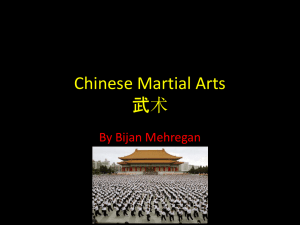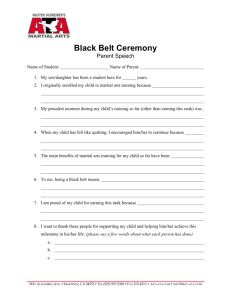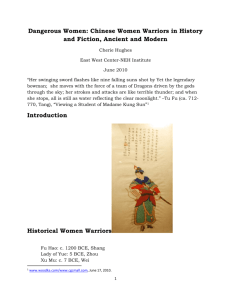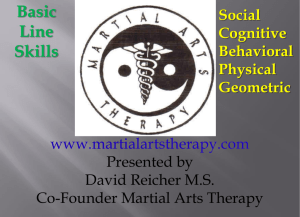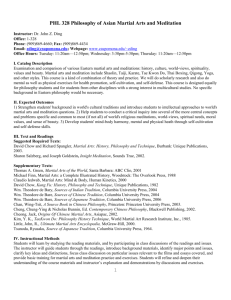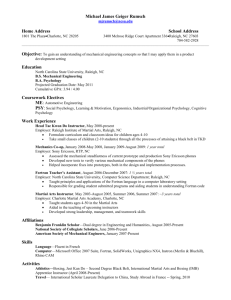Chinese Martial Arts
advertisement
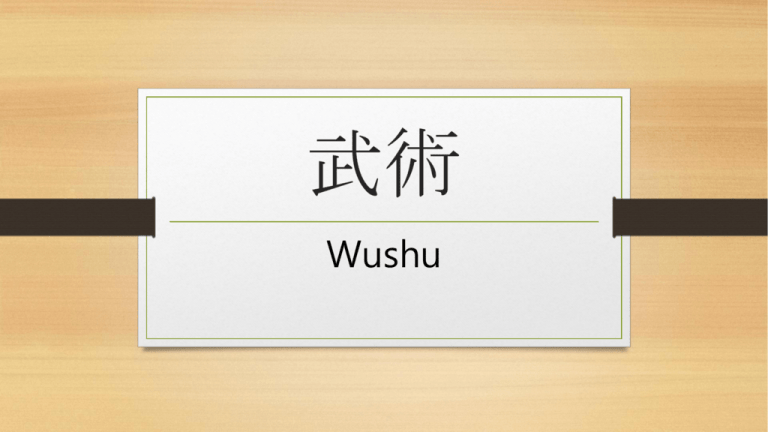
武術 Wushu A slide show for the benefit of ASH4402-13Spring 0W61 Shaolin Temple Grand Masters This work has been released into the public domain by its author, shaolin-world.net. This applies worldwide. In case this is not legally possible: shaolin-world.net grants any entity the right to use this work for any purpose, without any conditions, unless such conditions are required by law. Chinese Martial Arts The Chinese culture of martial arts is the oldest in the world. Popular culture has had a huge impact on how the Chinese culture of martial arts is seen by the world. Whether for entertainment or as a combat art, the practice of martial arts continues unabated in China. Chinese martial arts have fallen behind those of Japan, Korea, and Thailand on the world stage. Chinese martial arts look to find their way in the new millennium. Painting in the Shaolin Temple This image (or other media file) is in the public domain because its copyright has expired. This applies to Australia, the European Union and those countries with a copyright term of life of the author plus 70 years. Origins Chinese martial arts trace back to the earliest written history of China. Chinese martial arts were used on a large scale by soldiers in the Warring States period. Boxing was considered the staple element of training. Martial arts was the primary form of military training all the way through the Qing dynasty. The Chinese martial arts have always been shrouded in mysticism. The Chinese martial arts have not often caught the eye of scholars doing research. Tai Chi Chuan on the Bund in Shanghai, China. Photography by Jgremillot, December 2005. You are free: to share – to copy, distribute and transmit the work to remix – to adapt the work Under the following conditions: attribution – You must attribute the work in the manner specified by the author or licensor (but not in any way that suggests that they endorse you or your use of the work). share alike – If you alter, transform, or build upon this work, you may distribute the resulting work only under the same or similar license to this one. Origins Research on martial arts is often difficult due the dearth of articles. It may be that the myth that surrounds them acts as a deterrent. It also could be that the myth allows people to become dismissive and lack interest in martial arts. It could also be much of martial arts is a less than ideal combat technique from a modern military perspective. There is no question that this perception holds true for Chinese martial arts. 戚繼光 Qi Jiguang This image (or other media file) is in the public domain because its copyright has expired. This applies to Australia, the European Union and those countries with a copyright term of life of the author plus 70 years The General Qi Jiguang was a general who wrote a book on martial arts. He was known for fighting against pirates. He suggests that even at this time martial arts had become a from of entertainment, a pastime of sorts. He emphasized counter attack as a technique. He created a routine of boxing that had 32 forms. Qi Jiguang Statue in Fuzhou I, the copyright holder of this work, release this work into the public domain. This applies worldwide. In some countries this may not be legally possible; if so: I grant anyone the right to use this work for any purpose, without any conditions, unless such conditions are required by law. Mysticism The Shaolin Monastery is no doubt steeped in mysticism and it is a good example of the prominence of myth surrounding Chinese martial arts culture. The first myth is that the monks themselves created Chinese martial arts. Although some might want to preserve this romantic notion, the evidence does not support it. Chinese martial arts are a product of Chinese culture at large. Mysticism Chinese martial arts were practiced before the construction of the Shaolin Temple and also before Buddhism came to China. The monks practice of martial arts was very practical. Monasteries in China as in Europe were centers of wealth and as such prone to raided by thieves. The monastery fell in the Yuan dynasty, but it was later restored. Chinese martial arts continued in the presence of the monastery and without it. Special thanks to Stanley E. Henning Without whose work this would not have been possible http://seinenkai.com/articles/henning/index.html Sources Slide 4: Chinese Martial Arts Confront the 21st Century by Stanley E. Henning Slide 6 and 8: Academia Encounters the Chinese Martial Arts by Stanley E. Henning Slide 10: General Qi Jiguang's Approach to Martial Arts Training by Stanley E. Henning Slide 12 and 13: Martial Arts Myths of Shaolin Monastery Part I: The Giant with the Flaming Staff By Stanley E. Henning
